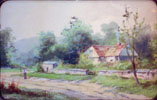Painting sizes, media, and number
3.4 Sizes and media
 |
| Yosemite Valley, California, from Artist's Point [1] (attributed), 42 by 70 inches |
Although he frequently depicted grand wilderness spectacles such as Yosemite Valley, Mount Hood, and Mount Shasta, in only a half dozen known paintings did Schafer use a canvas exceeding the 30 by 50 inch size that was apparently the custom for Mechanics Hall exhibitions at the time. The largest paintings reported are 42 by 70 inches; there are apparently no wall-sized paintings such as those sometimes painted by Bierstadt, Keith, and Hill, each of whom produced canvases of 70 by 100 inches or larger. A majority of Schafer's horizontally-oriented studio paintings are on a canvas of 30 by 50 inches, while the vertically-oriented works are usually on a canvas of 30 by 20 inches. There are also many smaller paintings ranging down to around 6 x 10 inches in size that appear to be field sketches, and two miniature watercolors, 3 by 5 inches, have emerged.
 |
| [Farmer, farmhouse, and dirt road] |
By far the majority of Schafer's works are oil on canvas, though some of the small oils are done on canvas-covered artist's board (in addition, later conservators and restorers have laid some of the small canvases down on board). There are about twenty watercolors and gouaches, generally on some kind of artist's board. Several of these are dated, and the dates are very late in Schafer's career: 1898 and later, though some of the undated watercolors seem to be German, which would place them at the beginning of his career. An undated example is at the left and a list of these paintings may be found in the index of watercolor and gouache paintings.
In addition to conventional media, Schafer painted a set of wall murals and a ceiling fresco for the Oak Grove Masonic Lodge in Alameda, California and, as mentioned in Schafer's background and training, scenery used in Oakland, San Francisco, and Los Angeles theatres.
3.5 On the number of paintings by Schafer
This inventory lists over 1350 painting titles, which have been found in sources ranging from auction lists of the 1880s to current dealer inventory. Of these, about 850 have been located and documented; The unlocated titles include many for which no information beyond the title is available, which means that there is no way to match them with documented paintings. At the same time, since a primary market for Schafer's paintings was in San Francisco and much of his work was executed before 1906, some—perhaps many—of the unlocated paintings from nineteenth-century lists were undoubtedly lost in the fires that followed the San Francisco earthquake that year.
Although the number of previously uncatalogued Schafer paintings reported in any given year can be wildly variable, over the decade ending in 2024 approximately 120 paintings from previously unknown collections emerged, an average rate of about twelve per year. In addition, about ten of the 850 previously catalogued paintings are reported to change hands each year, which would suggest that paintings tend to stay in the same ownership for an average of about 85 years. That length is probably overstated because not all ownership transfers are reported, but it is roughly consistent with anecdotes that frequently say that they were handed down within a family for two or three generations before they were sold. Given that the rate that paintings change ownership is about the same as the rate that previously uncatalogued paintings emerge, one can speculate that about half of the still-existing Schafer paintings are now documented.
3.6 Copies and reproductions of Schafer paintings
Schafer's great-grandson has reported that in his later years the artist was plagued by a "copycat". See the legend "A copycat and a sidearm" for more details. In addition, the proprieter of Galerie Mongeon in Seattle reported that he had in his inventory, in addition to a genuine Schafer painting, an example of a copy, but he provided no further information.
In recent years auction houses have been posting on the Internet high-resolution images of art works in upcoming sales. This practice has attracted vendors, mostly in China, to offer to prepare hand-painted copies of some of those works, even allowing the purchaser to choose the size. Copies of a dozen or so of Schafer's paintings, all of which are out of copyright, have been advertised for sale, primarily on eBay. Examples have not been examined to see if they are marked in any way to show that they are copies. Making copies of old paintings is an ancient Chinese tradition, as well as a modern high-volume business. Byung-Shul Han's book Shanzai: Deconstruction in Chinese explores this topic in depth and it is summarized briefly in this article.
In addition, entrepreneurs using the same high-resolution images have employed high-resolution inkjet technology to make mechanical reproductions called "giclees" (from the French gicler, "to squirt") on various supports, most often canvas or paper. Several of Schafer's paintings are now offered in this form.